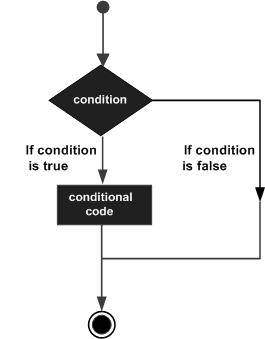Following is the general from of a typical decision making IF...ELSE structure found in most of the programming languages:

The if Statement:
An if statement consists of a Boolean expression followed by one or more statements.
Syntax:
The syntax of an if statement is:
if(Boolean_expression)
{
// Statements will execute if the Boolean expression is true
}
|
If the boolean expression evaluates to true then the block of code inside the if statement will be executed. If not the first set of code after the end of the if statement(after the closing curly brace) will be executed.
Example:
object Test {
def main(args: Array[String]) {
var x = 10;
if( x < 20 ){
println("This is if statement");
}
}
}
|
This would produce following result:
C:/>scalac Test.scala C:/>scala Test This is if statement C:/> |
The if...else Statement:
An if statement can be followed by an optional else statement, which executes when the Boolean expression is false.
Syntax:
The syntax of a if...else is:
if(Boolean_expression){
//Executes when the Boolean expression is true
}else{
//Executes when the Boolean expression is false
}
|
Example:
object Test {
def main(args: Array[String]) {
var x = 30;
if( x < 20 ){
println("This is if statement");
}else{
println("This is else statement");
}
}
}
|
This would produce following result:
C:/>scalac Test.scala C:/>scala Test This is else statement C:/> |
The if...else if...else Statement:
An if statement can be followed by an optional else if...else statement, which is very usefull to test various conditions using single if...else if statement.
When using if , else if , else statements there are few points to keep in mind.
- An if can have zero or one else's and it must come after any else if's.
- An if can have zero to many else if's and they must come before the else.
- Once an else if succeeds, none of he remaining else if's or else's will be tested.
Syntax:
The syntax of a if...else if...else is:
if(Boolean_expression 1){
//Executes when the Boolean expression 1 is true
}else if(Boolean_expression 2){
//Executes when the Boolean expression 2 is true
}else if(Boolean_expression 3){
//Executes when the Boolean expression 3 is true
}else {
//Executes when the none of the above condition is true.
}
|
Example:
object Test {
def main(args: Array[String]) {
var x = 30;
if( x == 10 ){
println("Value of X is 10");
}else if( x == 20 ){
println("Value of X is 20");
}else if( x == 30 ){
println("Value of X is 30");
}else{
println("This is else statement");
}
}
}
|
This would produce following result:
C:/>scalac Test.scala C:/>scala Test Value of X is 30 C:/> |
Nested if...else Statement:
It is always legal to nest if-else statements, which means you can use one if or else if statement inside another if or else if statement.
Syntax:
The syntax for a nested if...else is as follows:
if(Boolean_expression 1){
//Executes when the Boolean expression 1 is true
if(Boolean_expression 2){
//Executes when the Boolean expression 2 is true
}
}
|
You can nest else if...else in the similar way as we have nested if statement.
Example:
object Test {
def main(args: Array[String]) {
var x = 30;
var y = 10;
if( x == 30 ){
if( y == 10 ){
println("X = 30 and Y = 10");
}
}
}
}
|
This would produce following result:
C:/>scalac Test.scala C:/>scala Test X = 30 and Y = 10 C:/> |
0 comments: on "Scala - IF...ELSE"
Post a Comment